The Samsung 750 EVO (120GB & 250GB) SSD Review: A Return To Planar NAND
by Billy Tallis on April 22, 2016 8:00 AM ESTATTO
ATTO's Disk Benchmark is a quick and easy freeware tool to measure drive performance across various transfer sizes.
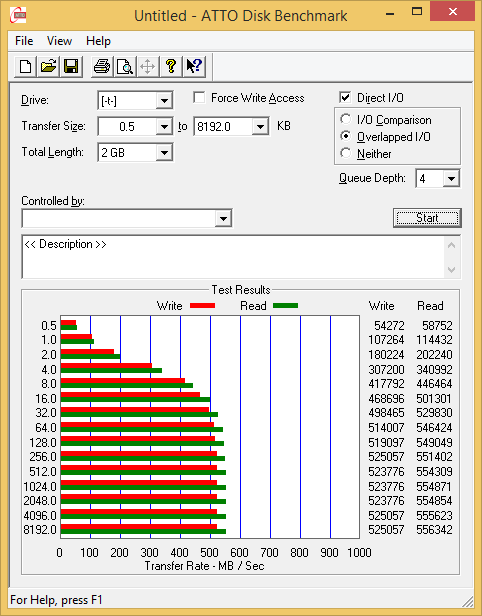 |
|||||||||
The ATTO benchmark shows the 750 EVO has good performance on small transfers and a maximum write speed that is very close to the read speed. The 120GB 750 EVO even provides better write speeds than the 850 Pro 128GB thanks to the former's SLC write caching.
AS-SSD
AS-SSD is another quick and free benchmark tool. It uses incompressible data for all of its tests, making it an easy way to keep an eye on which drives are relying on transparent data compression. The short duration of the test makes it a decent indicator of peak drive performance.
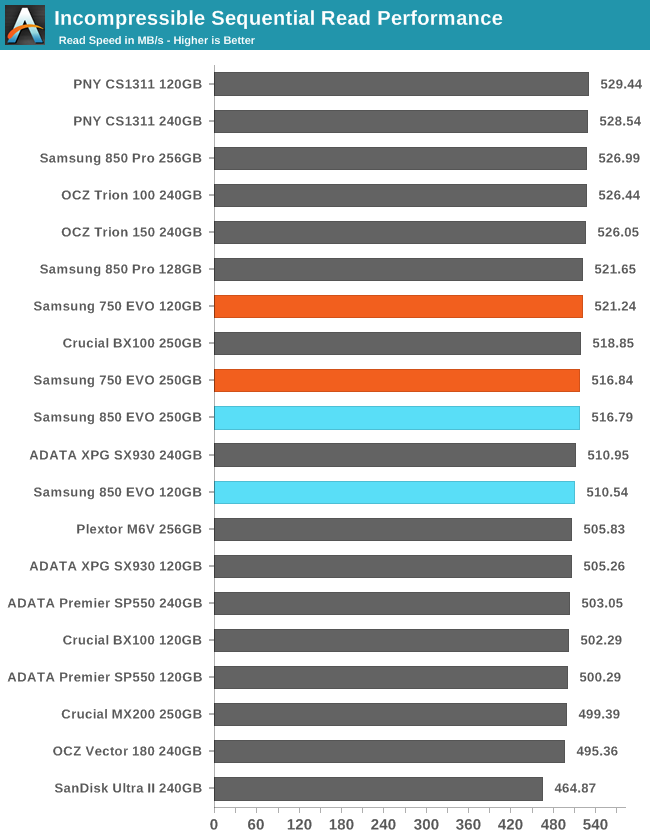
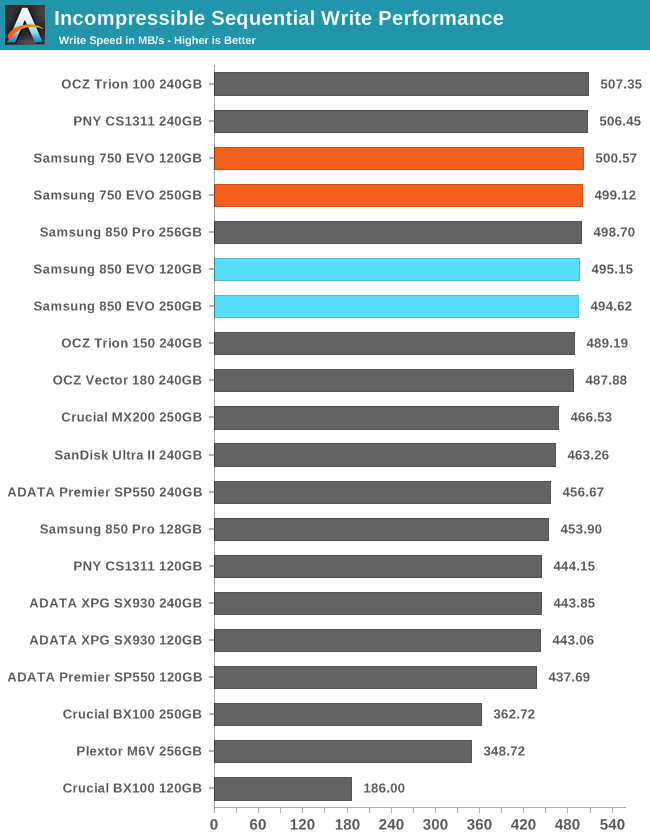
The 750 EVO provides top-notch burst speeds for reads and writes. The write speeds in particular distinguish the 750 EVO from most other TLC drives and low-end MLC drives that suffer from a lack of parallelism at small capacities.
Idle Power Consumption
Since the ATSB tests based on real-world usage cut idle times short to 25ms, their power consumption scores paint an inaccurate picture of the relative suitability of drives for mobile use. During real-world client use, a solid state drive will spend far more time idle than actively processing commands. Our testbed doesn't support the deepest DevSlp power saving mode that SATA drives can implement, but we can measure the power usage in the intermediate slumber state where both the host and device ends of the SATA link enter a low-power state and the drive is free to engage its internal power savings measures.
We also report the drive's idle power consumption while the SATA link is active and not in any power saving state. Drives are required to be able to wake from the slumber state in under 10 milliseconds, but that still leaves plenty of room for them to add latency to a burst of I/O. Because of this, many desktops default to either not using SATA Aggressive Link Power Management (ALPM) at all or to only enable it partially without making use of the device-initiated power management (DIPM) capability. Additionally, SATA Hot-Swap is incompatible with the use of DIPM, so our SSD testbed usually has DIPM turned off during performance testing.
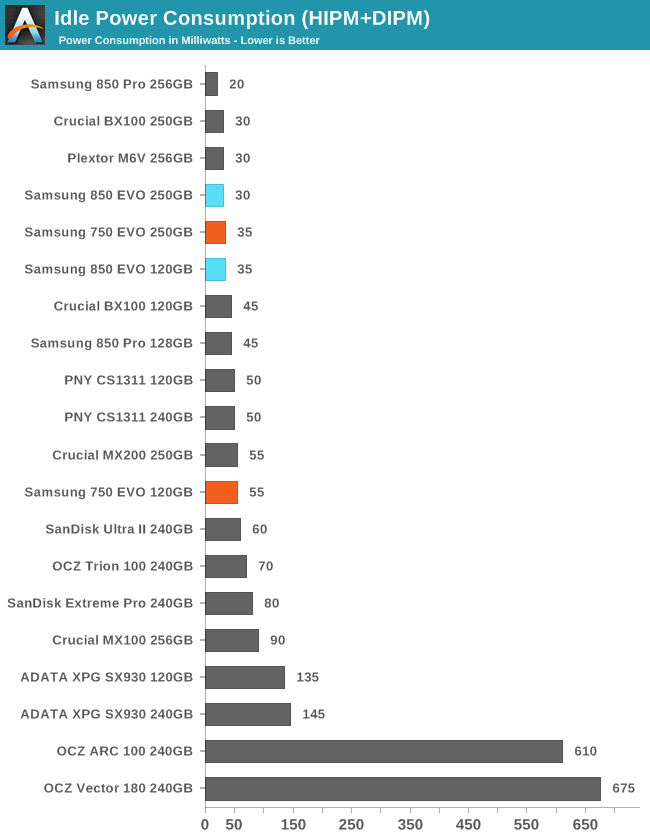
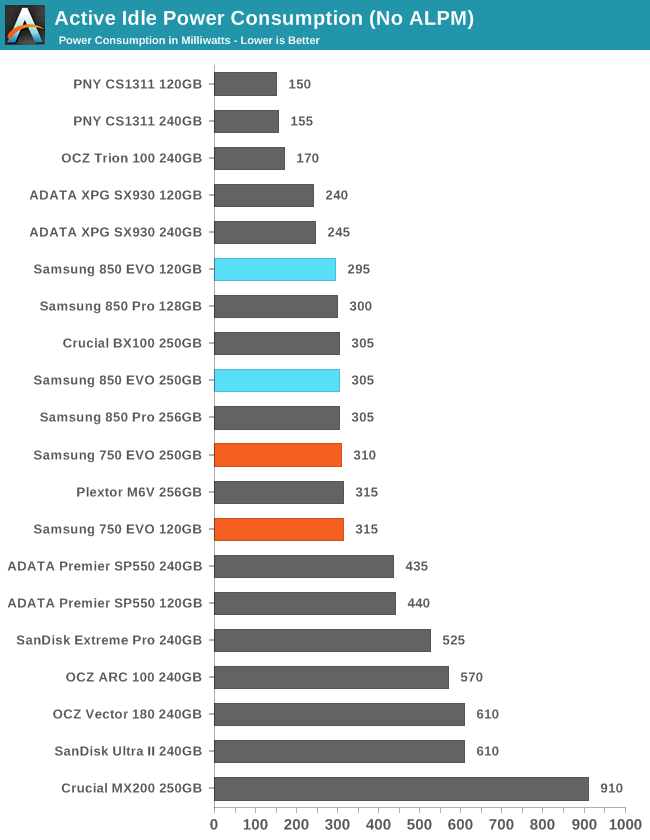
Idle power consumption of the 750 EVO is comparable to other Samsung drives: great when ALPM is enabled, and average when it is disabled.










109 Comments
View All Comments
Coup27 - Friday, April 22, 2016 - link
SATA is not yesterdays tech.abrowne1993 - Friday, April 22, 2016 - link
More like yesteryearDeath666Angel - Friday, April 22, 2016 - link
So, everyone with perfectly capable CPUs that are barely slower than current tech should upgrade because SATA is old? I'm not disputing that SATA is the older tech, I'm just looking for a more nuanced and realistic view here. If your workload is sufficiently dependant on IO throughput, by all means get those NVMe drives. But implying that a SATA3 device like a 850pro is not going to do the job for a lot of people.... I have a Z87 4770k running at 4.5GHz. I'm not going to upgrade just for the convenience of M.2 PCIe NVMe support. And I won't do so until 6+ core CPUs with comparable IPC and OC abilities get decently priced.Meteor2 - Saturday, April 23, 2016 - link
No, not at all, and no-one said SATA is inadequate. But it is part of the past, just like 486s and dial-up modems.Bleakwise - Sunday, April 24, 2016 - link
No, SATA has a place. You realize a 2.5 SATA drive has about 10x-20x the volume of a NVME drive. No reason you could n't have a 3.5 inch SATA SSD either.Thus SATA will always be the go-to for high volume storage. Flash memory isn't going to be shrunk down anytime soon either, it degrades both performance and reliability, so until we get something better than flash SATA is going to be the only place you can get something like a 4TB or 8TB SSD.
Bleakwise - Sunday, April 24, 2016 - link
Shinking thing smaller and smaller is also more expensive, and like I said in terms of flash it also degrades performance. It's much cheaper to build a big-fast thing than a small-fast thing.There is also the issue of RAID and mechanical drives for mass storage. I can setup a 20TB fakeraid with an SSD write-back cache for under a thousand dollars. Hardware raid would be about 2000$. The NVME version would be about 8000$ to 10000$.
Billy Tallis - Sunday, April 24, 2016 - link
There are 2.5" NVMe drives using the U.2 connector to provide the same 4 lanes of PCIe that can be supplied by the M.2 connector.slowdemon21 - Friday, April 29, 2016 - link
Agree. SATA is the skylake bottleneckewitte - Tuesday, May 24, 2016 - link
I hacked my bios to run a 950 pro in a z87 it was ridiculous to spend so much upgrading from a 4790k.Coup27 - Friday, April 22, 2016 - link
Do you not think there is something wrong with the phrase "consumer grade NVMe 2TB+ SSD" ?You could also RAID some SATA 2TB SSD's to give you want you need. I doubt you "really" need all of that space on NVMe, so maybe a 256 or 512GB 950 Pro + some 850 EVO's in RAID would work well, and is available now.